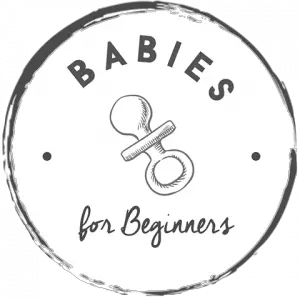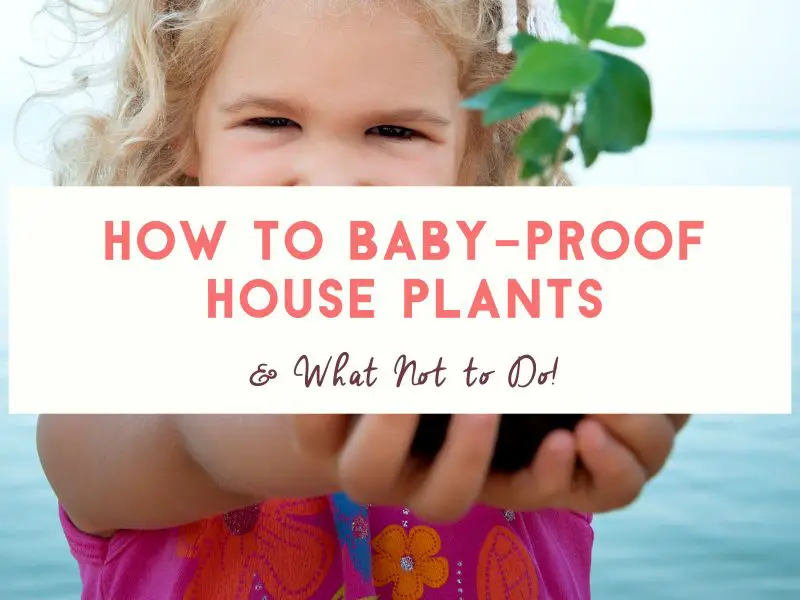Many common houseplants are poisonous or can pose a choking hazard, making it crucial to babyproof them.
In this article, we will explore the best and worst ways to babyproof your houseplants to keep your little one safe.
Table of Contents
Best Ways to Babyproof Your Houseplants
Get the Plants Out of Baby’s Reach
One of the most effective ways to baby-proof your houseplants is by placing them out of your baby’s reach.
By doing so, you eliminate the possibility of your baby getting into the plant or soil, which can be dangerous or tipping the plant on top of them.
Place your plants on high shelves, hang them from the ceiling using a cute plant hanger, or use a sturdy plant stand.
Use a Tall Outer Pot
Using a tall outer pot is a great way to babyproof floor plants.
An outer pot that’s taller than your kiddo’s reach can help keep your baby away from the tempting dirt playground that is a floor plant. With that said, it’s important to choose a pot without horizontal slots or other features that could be climbed on to avoid accidents.
Use Plant Pot Covers
Another effective way to baby-proof your houseplants is by purchasing and using plant pot covers. Plant pot covers help prevent your baby from getting into the soil or pulling out the plant.
Plant pot covers are available in various materials, including fabric and plastic, and are easy to install. More importantly, once installed they are sturdy and resistant to tampering unlike some DIY covers made from burlap or landscape fabric, which I’ll cover in the next section about what not to do when baby-proofing your plants.
Make a Plant Cabinet
Making a plant cabinet is a great baby-proofing method for houseplants because it provides a safe and secure space for your plants that is out of reach of your baby. A plant cabinet is a cabinet with a glass door or mesh screen that allows light to pass through but keeps your baby from reaching the plants inside. It’s a great solution if you have several plants that you want to keep out of reach, or if you have plants that require a specific environment, such as high humidity or constant temperatures.
To build a plant cabinet, you will need some basic woodworking skills, tools, and materials. You can find instructions on how to build a plant cabinet by searching online for DIY tutorials or visiting websites that specialize in woodworking projects. There are also many books and magazines available that provide detailed instructions on how to build a plant cabinet.
Once you have built the plant cabinet, you can place your plants inside and lock the door to keep them out of reach of your baby.
A plant cabinet not only provides a safe space for your plants, but it can also add to your home’s decor and keep your plants healthy by maintaining a consistent environment.
Choose Stable Plants in Sturdy Pots
If you have plants that are prone to tipping over, consider replanting them into sturdy pots to prevent accidents.
Tippy plants can be dangerous for babies as they can fall and injure them. Replanting them into sturdy pots can keep them in place and prevent accidents.
Get Rid of Poisonous Houseplants
Some houseplants are poisonous and can cause serious harm to your baby. It’s important to identify and remove any poisonous houseplants from your home.
If you don’t know what your plant is, you can use Google Lens to search for it; here is a quick video showing you how to look up a plant with Google Lens on a Pixel or android phone:
And here is a quick video showing you how to look up a plant with Google Lens on an iphone:
Examples of poisonous houseplants include:
- Dumb cane,
- Several types of ivy, including cape, English, German, Glacier, Gloire de Marengo, and Needlepoint,
- Aloe vera,
- Mistletoe,
- Umbrella plant,
- And many many more.
Start Teaching Them Early
Teaching your child to respect the plants and not touch them is essential in keeping both the plant and your kiddo safe.
You can start doing this by letting them be involved in watering the plants and teaching them early on not to touch the soil, leaves, etc.
Worst Ways to Babyproof Your Houseplants
Using Cling Wrap to Cover the Soil
Using cling wrap to babyproof houseplants may seem like an easy and cost-effective solution when you read it on plant blogs across the internet, but it can pose several dangers to your baby.
Cling wrap is a thin plastic film that is not breathable and can easily suffocate a child who accidentally ingests or inhales it. As such, using cling wrap to cover the soil of your houseplants can be VERY hazardous to your child, especially if they are in the crawling or early walking stage, wherein everything they find is going to end up in their mouth.
In addition to being a suffocation risk, using cling wrap to cover the soil can also make watering your plants difficult. Unless you poke a hole in it, the wrap just blocks you from watering the soil. Furthermore, cling wrap is not an effective barrier for preventing babies from accessing the soil of houseplants. Babies can easily pull off the wrap or poke holes in it, allowing them to access the soil and potentially ingest it.
Instead of using cling wrap, it’s better to use safer methods such as plant pot covers, which are specifically designed to protect the soil from spills or accidental contact.
Using Burlap or Landscaping Fabric and Landscaping Pins
Using burlap or landscaping fabric and landscaping pins to babyproof houseplants may also seem like an effective and affordable solution, but unfortunately, they still pose several dangers to your baby.
The pins you would need to use to hold the burlap or landscaping fabric in place (otherwise it won’t stay down at all) are sharp and can easily be pulled up by a baby, posing an obvious safety hazard. If the baby pulls up the pins, they can injure themselves by poking themselves with the sharp ends or swallowing the pins.
Conclusion:
Keeping your houseplants babyproof is essential to ensure the safety of your little one.
By using safe and effective methods, you can protect your baby from harmful plants and accidents. Always remember to choose safe plants and sturdy pots, keep plants out of reach, and teach your child to respect the plants.
With these tips, you can enjoy your houseplants while keeping your baby safe.
FAQ’s
Is It Bad if My Child Eats Potting Soil?
Ingesting small amounts of potting soil is generally not harmful to children, as it is made of organic materials such as peat moss, perlite, vermiculite, and compost, which are non-toxic.
However, it’s important to keep in mind that potting soil may contain harmful bacteria such as E. coli or Salmonella, which can cause gastrointestinal problems if ingested in large amounts.
In addition, potting soil may also contain fertilizer, pesticides, or other additives, which can be harmful if ingested in large amounts.

